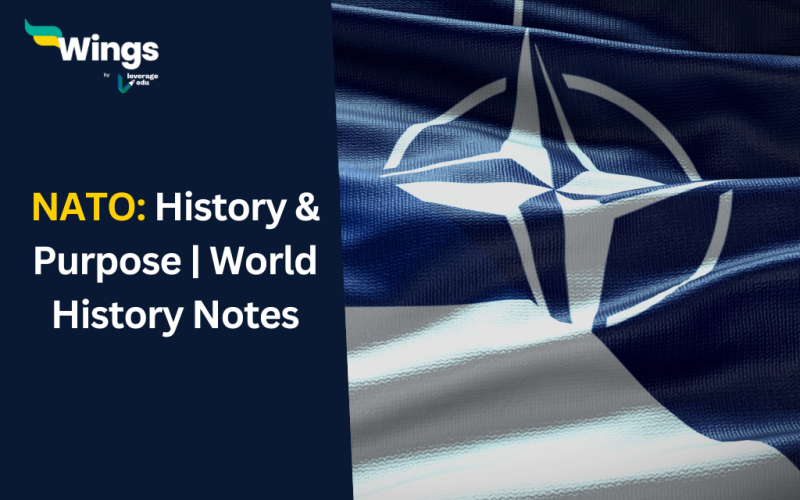Hey, guys! Mr. Owl 
Table of Contents [show]
 What is NATO? When was NATO Established?
What is NATO? When was NATO Established?
NATO is the full form of North Atlantic Treaty Organization. NATO was officially established in the year 1949. It is a military alliance that was created to counteract Soviet armies that were stationed in central and eastern Europe after the end of World War II and during the Cold War phase. After the end of the Cold War, the organisation then became a “cooperative-security” organization. At present, this organisation has 31 countries as its members.
Quick Facts About NATO
- In 2021, NATO deployed troops to Afghanistan to help evacuate civilians and allied personnel after the Taliban took over Afghanistan.
- In 2022, Ukraine received military assistance to protect itself from Russian invasion.
- NATO is headquartered in Brussels, Belgium.
 NATO Complete Timeline
NATO Complete Timeline
- In 1949 around twelve countries namely Belgium, Canada, Denmark, France, Iceland, Italy, Luxembourg, the Netherlands, Norway, Portugal, the United Kingdom, and the United States signed the North Atlantic Treaty which led to the formation of NATO.
- In 1952, Greece and Turkey joined NATO.
- In 1955, West Germany also became a part of NATO.
- In 1966, France withdrew from NATO’s military command structure however chose to remain an active member of the alliance itself.
- Spain also joined NATO in 1982.
- After the dissolution of the Warsaw Pact, NATO established the NACC (North Atlantic Cooperation Council) which acted as a bridge for dialogue and mutual cooperation between NATO and ex-Warsaw Pact members.
- In 1994, NATO ratified the PFP (Partnership for Peace) program in order to build closer ties with non-member countries.
- In 1999, NATO was joined by the Czech Republic, Hungary, and Poland. Additionally, NATO launched a campaign against Yugoslavia to stop the Kosovar genocide.
- From 2004-2020, many countries from different continents of the world became a part of NATO.
- In 2022, Sweden and Finland applied to join NATO in response to the Russian invasion of Ukraine. Furthermore, NATO also deployed troops to member countries in Eastern Europe to combat Russian aggression.
Must Read: 
 Who Created NATO and Why?
Who Created NATO and Why?
Nato was formed when the United States, Canada, and several Western European nations joined hands to limit the growing power and influence of the Soviet Union in Europe.
The motivation behind the creation of NATO relied on the following factors-
- Limit the USSR and its global influence.
- Promoting peace, unity, cooperation and capitalist ideology amongst Western democracies.
- To have a collective defence system. This principle helped to deter the Soviet Union from attacking any of the NATO member states.
NATO’s objectives have changed over the years of its existence, at present some of its objectives are as follows-
- Deter and defend against all kinds of threats, including hybrid and cyber threats.
- Promoting peace and stability in the Euro-Atlantic area.
- Protecting critical infrastructure.
- Developing and maintaining capabilities to project power and conduct crisis management operations.
- Enhancing partnerships and cooperation with other countries.
 List of Countries in NATO
List of Countries in NATO
Following are the countries that are the present-day members of NATO-
- Albania
- Belgium
- Bulgaria
- Canada
- Croatia
- Czech Republic
- Denmark
- Estonia
- Finland
- France
- Germany
- Greece
- Hungary
- Iceland
- Italy
- Latvia
- Lithuania
- Luxembourg
- Montenegro
- Netherlands
- North Macedonia
- Norway
- Poland
- Portugal
- Romania
- Slovakia
- Slovenia
- Spain
- Sweden
- Turkey
- United Kingdom
- United States
 How Did NATO Counteract Warsaw?
How Did NATO Counteract Warsaw?
NATO acted as a formidable force against Warsaw by-
- Military Deterrence
- Employing Forward Defence
- Military Training and Exercises
- Public Diplomacy
- Having Valuable Intel on the Soviet Union to stay ahead of its plans.
 Does NATO Still Exist?
Does NATO Still Exist?
Yes, NATO still exists with around 31 members in its organisation. NATO now also acts as a forum that addresses security issues and provides consultation. Furthermore, it has also immersed itself in roles of a peacekeeper, peace-builder and diplomat.
 Quiz
Quiz
Results
#1. How many member nations does NATO has right now?
#2. In which year was NATO established?
#3. When was the Brussels Treaty signed?
“Kiddos, I’ve answered all your queries with the utmost precision that I was capable of. Now, I’ll be taking my leave, but if you think I might have missed something, do check out the FAQ section or drop a comment. I always respond!
Also Read: What is Socialism? Definition, History, and Significance
FAQs
NATO is the full form of North Atlantic Treaty Organization. NATO was officially established in the year 1949. It is a military alliance that was created to counteract Soviet armies that were stationed in central and eastern Europe after the end of World War II and during the Cold War phase.
The full form of NATO is North Atlantic Treaty Organization.
The year 1949 marked the formation of NATO.
RELATED BLOGS
Hope you have gotten all the relevant information about what is NATO! If you want to know more about topics like this, then visit our general knowledge page! Alternatively, you can also read our blog on general knowledge for competitive exams!
 One app for all your study abroad needs
One app for all your study abroad needs


















 45,000+ students trusted us with their dreams. Take the first step today!
45,000+ students trusted us with their dreams. Take the first step today!
